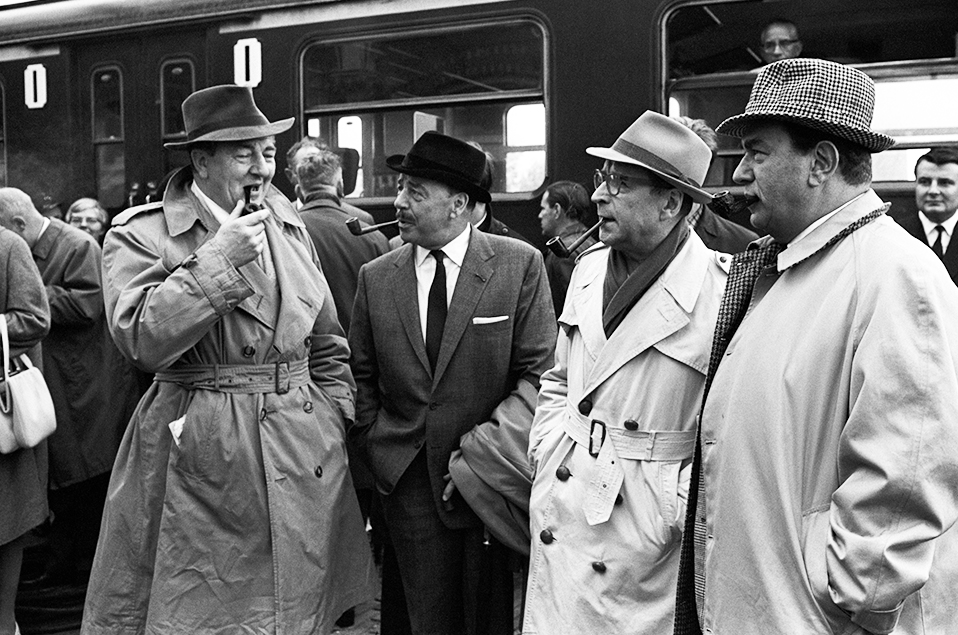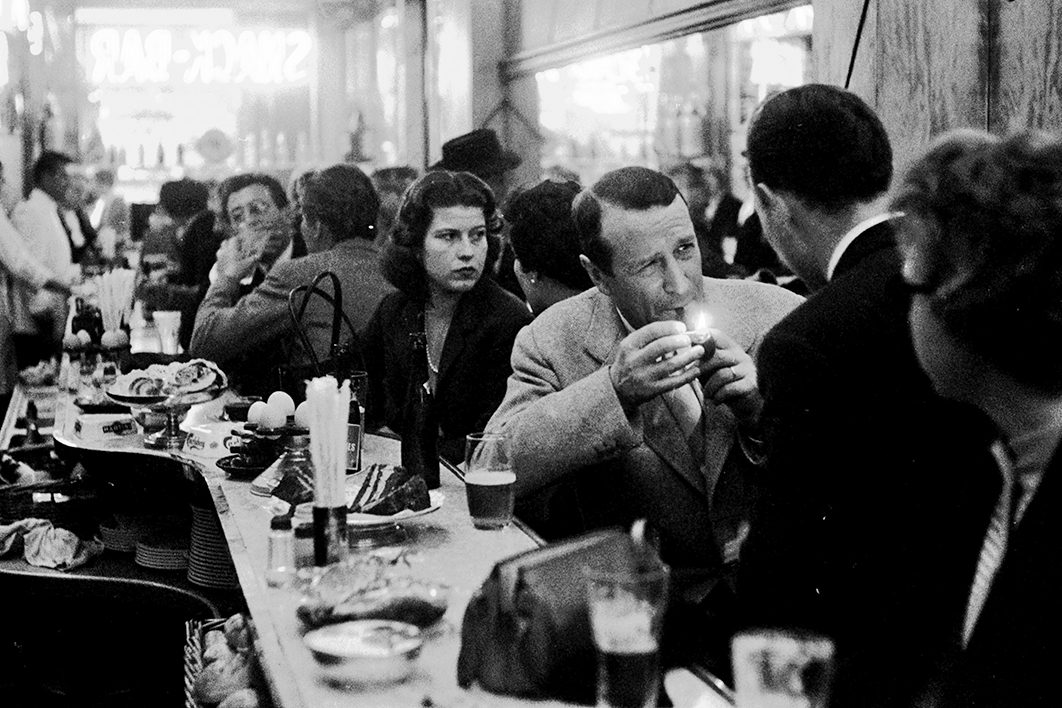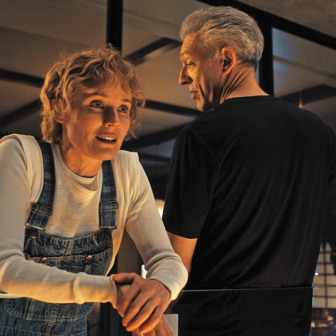Anyone who embarks on a course of Georges Simenon’s Maigret novels — and it is difficult to stop at just one — will recognise the characteristically cinematic quality of his prose. It’s an overused word for describing modern fiction, detective fiction in particular, but in Simenon’s case it is entirely merited. Every page, every paragraph, contains a picture.
These images come to us in atmospheric monochrome, street after Parisian or provincial street, defeated office workers dozing on park benches, women of the night, sad and trapped, bourgeois burghers, struggling to keep up a pretence of prosperity and contentment. It is a world beyond depressing and yet it draws us in until we want nothing so much as to be there, observing the lives of the world-weary, the frustrated and the disappointed, and luxuriating in it all.
Although Simenon was clearly influenced in his novels by the newer arts of cinema and photography — he was for a time a keen and talented photographer — he was not unduly bound by their already well-developed conventions. One of the best and most psychologically penetrating of the Maigret novels, Maigret and the Headless Corpse, begins with a standard opening scene, the discovery of a body (or in this case, a detached arm), but doesn’t quite follow the trajectory we might expect.
A river bargeman makes the gruesome find, hooking it up from the sludge at the bottom of the Canal-Saint-Martin. “It was a human arm, intact from the shoulder to the hand. In the water, it had taken on a pallid colour and the texture of a dead fish.” Contrary to what we might expect, there is no cinematic reaction shot. We are given no clue as to what the bargeman might be thinking. How to respond, and to imagine the horror of the scene, is left entirely to the reader. It is one of many small instances where Simenon establishes and maintains a direct connection between narrator and reader and helps to create that sense that we are part of his world.
Immersed in this world, we might join Maigret for a bistro lunch and a bottle of wine, typically shared with a colleague, while taking note of the habits and quirks of strangers. We can then head back to the Quai des Orfèvres in a regulation black Citroën, complete with suicide doors, perhaps for a restorative snooze before returning to the case. Or instead follow Maigret home for lunch, for something substantial prepared by Mme Maigret in their cocoon-like flat, finishing with a fruity digestif, a rustic prunelle perhaps.
These images come not only from Simenon’s novels but also from the countless film and television adaptations of the Maigret novels, and of some of the one-off romans durs, the hard novels, of which there are hundreds. (No one seems to know how many.) Some of the most recognised directorial names in French cinema — Jean Renoir, Marcel Carné, Claude Chabrol, Henri-Georges Clouzot, Bertrand Tavernier — have responded to the source material to considerable effect, while Maigret has been brought to life by some formidable actors — Michel Simon, Harry Baur and Jean Gabin among them.
Many other actors, some with the status of icons, some lesser known, have had a go. What is perhaps surprising is how many of them are good in the role, suggesting something about the character of Maigret that brings out the best. Choosing the “winner” has become a bit of a game among Maigret fans. Some favour Harry Baur’s early incarnation (too old for the part, was Simenon’s comment, which seems a bit harsh as Baur was fifty-three at the time) or Jean Gabin, whom he acknowledged got the language right.
Overall, Simenon is reported to have favoured the performance of the less stellar but entirely convincing Rupert Davies, in the BBC television series of the early sixties, so well received that it ran for four seasons and fifty-four episodes, and recently cheered fans old and new when the entire run was released on DVD.

Georges Simenon (second from right) in 1966 with three actors who played Maigret: British actor Rupert Davies (left), Dutch actor Jan Teuling and Italian actor Gino Cervi. Mondadori Portfolio/AAP
As adaptations moved from black and white to colour, something was lost. Black and white just seems truer to Maigret and his world. It speaks directly to images we as readers already have in our heads. Two of the most recent adaptations, the television series with Rowan Atkinson and the 2022 film Maigret, directed by Patrice Leconte and based on Maigret and the Dead Girl, with the great Gérard Depardieu in the title role, are among the least satisfactory.
Disappointed viewers have tended to focus on what are seen as their one-note performances — Atkinson too distractingly deliberate and lugubrious, Depardieu too glacially cerebral. But this is deflection. The real culprit is colour, that and the deadening accuracy of sophisticated twenty-first-century set and costume design.
The novels rely on a bedrock of realism, but the overwhelming impression is atmospheric, a quality that in general is more successfully rendered in monochrome. When the plot of a Maigret novel doesn’t quite make sense, as occasionally it doesn’t, it seems like a trivial criticism compared with the power of the atmosphere that remains with the reader. It is a remarkable achievement, to create a world that resonates so strongly, by means of “simple” prose and what Simenon himself described as deliberately restricted vocabulary.
Among the seventy-five novels that make up Penguin’s recent republication project is one that is not quite a novel at all. Maigret’s Memoirs, in a new translation by Howard Curtis, directly addresses the elision that formed quite early in the public mind between Maigret and his creator. Maigret recalls how his acquaintance with Simenon began, and how it evolved over the years into a wary friendship. He tries hard to provide instances in which his personality, appearance and policing methods have been manipulated and even falsified by Simenon in the interests of creating a character who purports to be him.
Yet for all his questioning of Simenon’s methods, Maigret is repeatedly if reluctantly obliged to acknowledge the point of Simenon’s creative alterations. “The concern for objectivity falsifies the truth,” the creator explains patiently to the literal-minded creation, adding that “the first quality of the truth is to be simple.”
Simenon freely acknowledges the discrepancies between fiction and “real life.” He is fully aware, he assures Maigret, “that a chief inspector… doesn’t run around the streets in person questioning concierges and bar owners.” His objective, he says again, is to simplify in the interests of truth, and Maigret must admit to himself that this is logical. Simenon’s hero is given his own direct voice in the Memoirs, but this merely serves to confirm that it is not a relationship of equals, but one of leader and subordinate.
For someone with a reputation for being unknowable, Simenon talked and wrote a lot about himself. When I Was Old is an absorbing account of his life in the years between 1960 — when he realised that at the age of fifty-nine he was now undeniably old — and 1963, when he achieved some sort of accommodation with this uncomfortable fact and the journal abruptly stops.
Here, his advocacy of simplicity becomes something of a mantra, couched in almost comically simple terms. “I don’t like big words,” he says, justifying his approach by his confidence that reality is “less falsified in the simple.” Yet Simenon is also playing with the reader. He knows that there is a disingenuousness to this apparent forthrightness. He is fully aware that his version of reality “trembles on the brink of unreality.” To put it another way, it’s all about the atmosphere.
Along with the novels, Penguin has also turned its attention to the short stories in which the inspector appears. Many of them, the exact number of which is again difficult to quantify, have not appeared in English before, including three of the five that are included in the recently published collection Death Threats and Other Stories, translated by Ros Schwartz. In the story that gives the collection its title, the plot hinges on a distinction that appears frequently in Simenon, the unbridgeable gap between the young and the old. The young are “healthy, muscular, lively,” they are “normal” and “carefree.” At some point, though, they become old, sometimes disconcertingly early, and in doing so they ruin “beautiful materials, a beautiful life, infinite possibilities.” It is both a highly romantic notion and a gloomy prospect.
This distinction between youth and age underpins much of Simenon’s work, both in the Maigret novels and the non-Maigret. One of the best of those available in English is The Strangers in the House — a novel with a detective of sorts at its centre, albeit very much a reluctant one — published in 2022 in a translation by the indefatigable Howard Curtis.
Hector Loursat is a disappointed man. His career as an attorney barely sputters along, his wife has left him long since and he is virtually estranged from his daughter, even though they live under the same roof. As so often in Simenon, the course of his life is dramatically altered by a sudden, disruptive event. A murder is committed, on the top floor, a part of his house which may as well be in another world, one where he never ventures.
Slowly and painfully Loursat drags himself out of his customary torpor and devotes himself to finding the truth, at the same time saving his daughter’s reputation and the life of the young man accused of the crime. In the process, Loursat recaptures, at least for a time, something of the optimism and energy of youth. The young had adventures, he laments, while their parents “pretended to be alive.”
The key to this reinvention and to solving the mystery is the rediscovery of simplicity, of clearing away the debris and getting to the essence. When the examining magistrate waffles on and on, circling round the point, Loursat interrupts him midstream by blowing his nose, “loudly, cynically, just to get it over with.” In pursuing the mystery, he finds that “it was indispensable to translate every sentence into plain language,” to discover what people are really saying.
The murder that takes place under his own roof offers the prospect of adventure, of the opportunity to play detective. In his dogged quest to get to the truth, Loursat “had the impression he was descending into life.” At the end of the novel, after he has succeeded in more or less resolving the case, we are left uncertain as to whether he will remain in life or once more withdraw. We last see him seated “all alone, still dignified, in a bistro, over a glass of red wine,” leaving the question of what happens next entirely open.
Numerous attempts have been made to capture what it is about Simenon that makes him so sheerly readable, that makes it difficult to read just one or two novels, get the flavour, and stop. The prolific commentator on crime fiction and noir, Barry Forshaw, has recently taken on the task in his Simenon: The Man, the Books, the Films, with rather mixed results.
A large proportion of this book, more than half, is devoted to a varyingly annotated bibliography, which goes as far as can reasonably be expected towards the unattainable goal of comprehensiveness. It includes all the works in which Maigret appears, a generous sampling of the non-Maigret novels, and a particularly useful itemising of the film and television adaptations of both categories of novels, stretching from 1931 (sometimes listed elsewhere as 1932) with Jean Renoir’s Night at the Crossroads, to 2022 and Jean Becker’s The Heart of a Man, based on the hard novel Les Volets Verts and starring the ubiquitous Gérard Depardieu. Patrice Leconte’s Maigret, however, arrived too late to make the list.
Among the more obscure and hard-to-obtain film versions, Forshaw makes an intriguing reference to a Franco-Australian co-production of 1958, The Stowaway, set in Tahiti and featuring a range of well-known Australian and European actors including, improbably, the incomparable French icon Arletty.
More rewarding are the companion chapters on aspects of Simenon and his world, including one on Maigret’s Paris, another on his influence on other writers and, most interesting of all, a chapter on translation that makes extensive use of Forshaw’s interviews with three of the distinguished translators assembled by Penguin to see through its Maigret project. Ros Schwartz, who has by her own count translated sixteen Simenon titles, points to the need for the translator to also be something of a detective in accurately representing the period detail. “In one description of a woman sleeping with ‘épingles’ in her hair at night, I eventually found the exact bobby pins advertised on eBay.”
Schwartz also refers to the real difficulties in replicating Simenon’s “extraordinarily economical” language. The other two translators make this same point. Howard Curtis scotches any thought that Simenon is an easy author to translate. “Time and again,” he says, “you come across beautifully turned phrases that sum up a character, a setting, a mood in the minimum of words, and it’s often a struggle, for a translator, to find equivalents in English.” Siân Reynolds phrases it with appropriate simplicity: “they are hard to translate because they are written simply.” These comments go to the heart of Simenon’s continuing and wide-ranging appeal — his unmatched ability to convey complexity, nuance and, above all, atmosphere in the seductive guise of simplicity. •
Maigret and the Headless Corpse
By Georges Simenon | Translated by Howard Curtis | Penguin | $19.99 | 192 pages
Maigret’s Memoirs
By Georges Simenon | Translated by Howard Curtis | Penguin | $22.99 | 149 pages
When I Was Old
By Georges Simenon | Translated by Helen Eustis | Penguin | $22.99 | 452 pages
Death Threats and Other Stories
By Georges Simenon | Translated by Ros Schwartz | Penguin | $22.99 | 181 pages
The Strangers in the House
By Georges Simenon | Translated by Howard Curtis | Penguin | $22.99 | 217 pages
Simenon: The Man, the Books, the Films
By Barry Forshaw | Oldcastle | $29.99 | 256 pages




